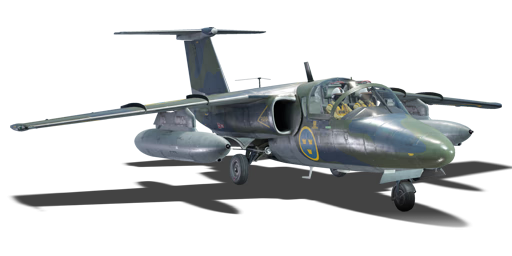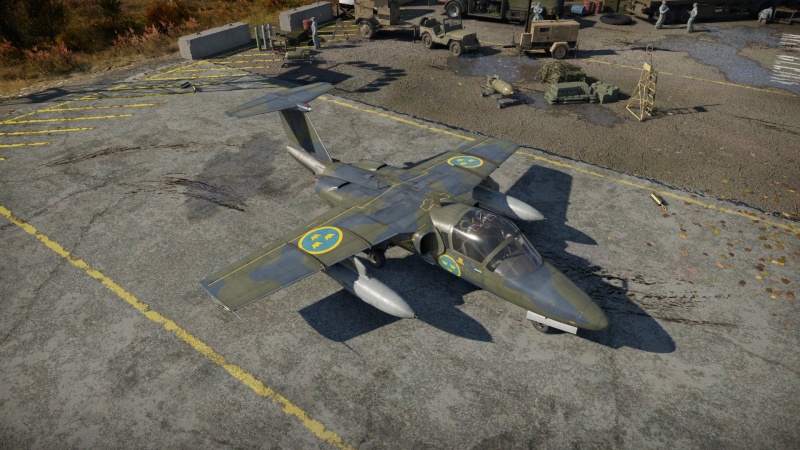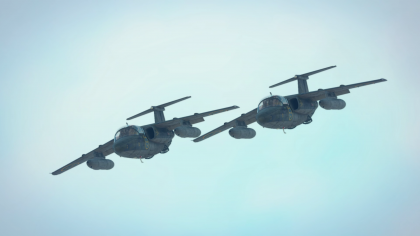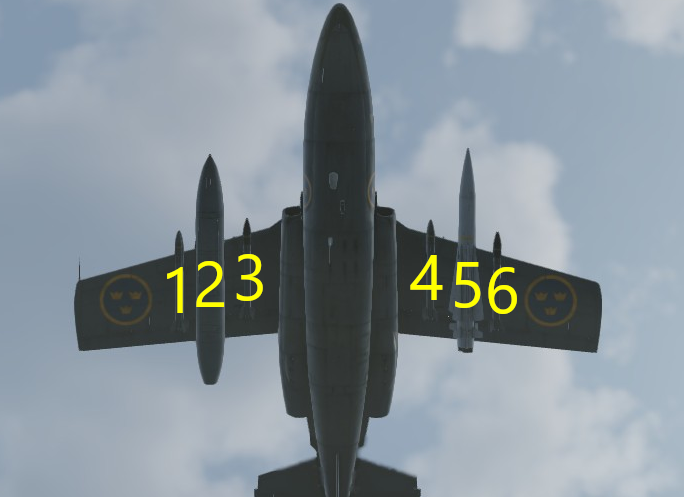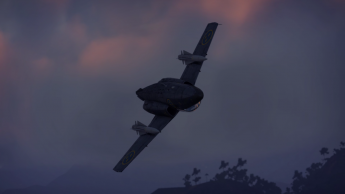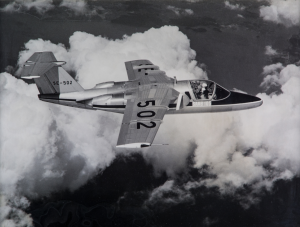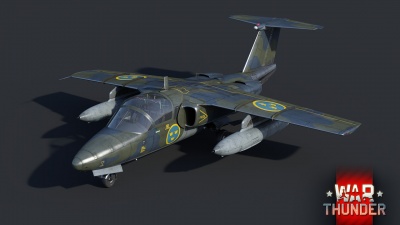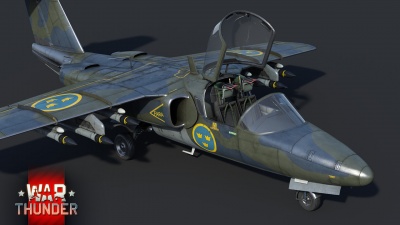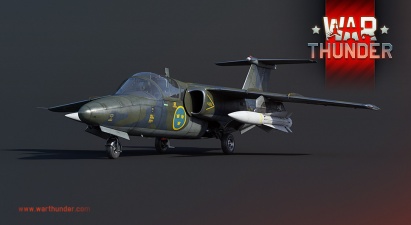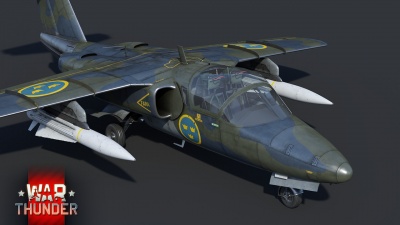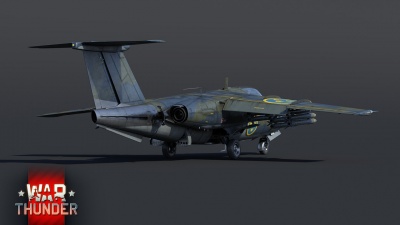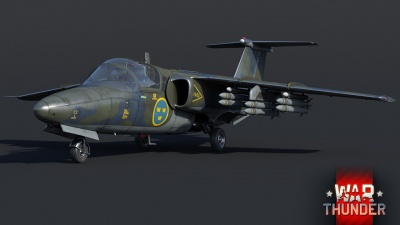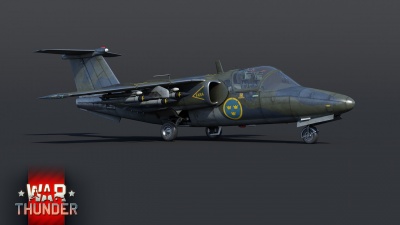SK60B
| This page is about the Swedish strike aircraft SK60B. For other versions, see SAAB-105 (Family). |
Contents
Description
The SK60 was developed for the Swedish Air Force after SAAB's attempt to develop a twin-engine jet aircraft for civilian and military use in 1959. After problems with decision making, it was decided to focus only on the military version of the aircraft. After a few years of development, the prototype first flew in 1963, with a total order of 150 units placed by the Swedish Air Force in 1964. The aircraft was known as SAAB 105, the aircraft was later modified for ground attack with 60 units receiving the new role, Austria later endorsed the SAAB 105, and ordered 40 units.
It was introduced in Update "New Power". The SK60B, better known as the Saab 105, is a light training vehicle designed for the Swedish army. The vehicle is incredibly light and nimble, and served as ground attacker, thanks to its versatile arsenal of suspended armaments. It has relatively weak engine power and a mediocre flight performance when compared to other aircraft such as the Su-11 and even the Vampire, it lacks access to bombs, however it does feature RB05 MACLOS guided missiles and rockets, it should be noted however, that the guns take the same pylons as the missiles.
General info
The SK60B is one of the more unique planes the Swedish tech-tree offers, especially at the higher ranks. The plane is fairly modern in comparison to jets of the same BR, sporting the same paint-scheme and armament as the much faster J35D. The SK60B is incredibly small, but with a wide fuselage to accommodate the twin-seat configuration the trainer offers. The wings are mounted in a high-up position, similar to planes like the La-15. The plane is propelled by two engines that are mounted just outside the fuselage, giving the plane a top speed of just around 800 km/h. The tail is of a T-shape design and works effectively at all speeds, contributing to good manoeuvrability and low stall-speed. Overall the SK60B is a fitting plane for pilots not yet used to jet combat. The plane flies like most piston-engine fighters, lacking in speed, but featuring supreme mobility and firepower. The SK60B doesn't feature any internal weaponry, but carries two Akan m/55 gunpods, with the same fire rate, burst mass, and positioning as the Draken. This firepower is one of the best at its rank, especially considering the SK60B carries almost twice the ammunition compared to the J35D. Although it's easy to feel godlike with firepower this immense, staying away from fully commit head-on engagements will definitely keep you alive a lot longer, as the SK60B isn't particularly survivable.
Flight performance
Being a trainer aircraft by nature, the SK60B is very forgiving in aerodynamics. The plane performs ideally at most speeds, and has a stall speed below 200 km/h, allowing for advanced manoeuvring without risking the pilot's life. The rudder and elevators respond quickly, and deflect even at speeds the airframe itself can't sustain. The ailerons are also powerful, allowing the SK60B to smoothly roll in engagements, which along with the other control surfaces, makes it superior in dogfights.
The flight performance isn't perfect, as the SK60B has obvious downsides from its trainer background. The SK60B is incredibly slow. The plane struggles to break above 700 km/h at most, and will slowly decrease in speed as the fight goes on, as manoeuvres bleeds speed. The SK60B has no real way to gain this speed back either, as the acceleration is sluggish. Although nothing out of the ordinary for early jets, the SK60B doesn't have the top speed to back this up compared to its peers, meaning that most low-altitude dogfights will result in the Saab being the "sitting duck" most of the time. Taking suspended armaments (which is a must) doesn't aid the overall engine performance. Even taking the Akan m/55 gunpods, which are considered aerodynamic, lowers the climb rate significantly, putting it below 20 m/s. Thankfully, the SK60B is classed as an attacker, giving it an altitude spawn of around 1,000 metres. A smart pilot goes for the altitude advantage, as it compensates for any lack of power the SK60B suffers from.
| Characteristics | Max Speed (km/h at 6,000 m) |
Max altitude (metres) |
Turn time (seconds) |
Rate of climb (metres/second) |
Take-off run (metres) | |||
|---|---|---|---|---|---|---|---|---|
| AB | RB | AB | RB | AB | RB | |||
| Stock | 760 | 741 | 10668 | 25.0 | 25.4 | 17.7 | 16.7 | 850 |
| Upgraded | 824 | 792 | 23.6 | 24.0 | 26.8 | 22.0 | ||
Details
| Features | |||||
|---|---|---|---|---|---|
| Combat flaps | Take-off flaps | Landing flaps | Air brakes | Arrestor gear | Drogue chute |
| X | ✓ | ✓ | ✓ | X | X |
| Limits | ||||||
|---|---|---|---|---|---|---|
| Wings (km/h) | Gear (km/h) | Flaps (km/h) | Max Static G | |||
| Combat | Take-off | Landing | + | - | ||
| 934 | 400 | N/A | 387 | 350 | ~12 | ~6 |
| Optimal velocities (km/h) | |||
|---|---|---|---|
| Ailerons | Rudder | Elevators | Radiator |
| < 650 | < 650 | < 580 | N/A |
Engine performance
| Engine | Aircraft mass | |||||||
|---|---|---|---|---|---|---|---|---|
| Engine name | Number | Basic mass | Wing loading (full fuel) | |||||
| Turbomeca RM9B | 2 | 2,262 kg | 204 kg/m2 | |||||
| Engine characteristics | Mass with fuel (no weapons load) | Max Takeoff Weight | ||||||
| Weight (each) | Type | 29m fuel | 30m fuel | 45m fuel | 60m fuel | 98m fuel | ||
| 298 kg | Low-bypass turbofan | 2,577 kg | 2,588 kg | 2,751 kg | 2,914 kg | 3,327 kg | 5,606 kg | |
| Maximum engine thrust @ 0 m (RB/SB) | Thrust to weight ratio @ 0 m (102%) | |||||||
| Condition | 100% | 102% | 29m fuel | 30m fuel | 45m fuel | 60m fuel | 98m fuel | MTOW |
| Stationary | 720 kgf | 763 kgf | 0.59 | 0.59 | 0.55 | 0.52 | 0.46 | 0.27 |
| Optimal | 720 kgf (0 km/h) |
763 kgf (0 km/h) |
0.59 | 0.59 | 0.55 | 0.52 | 0.46 | 0.27 |
Survivability and armour
The SK60B is lightweight, and thus forgoes any sort of armour protection to save weight. This decision is logical, as the SK60B was originally designed with only training purposes in mind. This can be experienced in-game, especially in the lack of cockpit protection, as the pilot and navigator will take turns getting killed in frontal attacks. It is thus never recommended to fully commit in a head-on engagement, as even if a pilot survives, the SK60B will become critically damaged, most likely causing it to crash. Even if the SK60B survives, the flight performance is heavily crippled, making the plane even slower than it already was.
Although weak, the SK60B has a few design tricks making its survivability advantageous, one of which is the engine layout. Since the SK60B is a twin-engine design, getting hit in one of these engines isn't considered fatal. The SK60B flies considerably well even using a single engine, making it back to base without any issue. Thanks to engines being slightly external, engine fires don't wound the overall fuselage as much as a single engine mount would. This makes putting out fires a bit easier, as the SK60B can just dive down to the deck with the engines shut off to extinguish it most of the time. The wings are also a strength of the SK60B. Although prone to breaking as the structure isn't particularly strong, the good aerodynamics allow the SK60B to fly despite missing a wing. The plane can also be easily landed after this, as the low stall speed, and robust fuselage, allow for effective emergency landings.
Modifications and economy
Armaments
Suspended armament
The SK60B can be outfitted with the following ordnance:
| 1 | 2 | 3 | 4 | 5 | 6 | ||
|---|---|---|---|---|---|---|---|
| 30 mm Akan m/55 cannons (150 rpg) | 1 | 1 | |||||
| m/56D rockets | 2 | 2 | 2 | 2 | 2 | 2 | |
| psrak m/49/56 rockets | 1 | 1 | 1 | 1 | 1 | 1 | |
| Rb05A missiles | 1 | 1 |
| Default weapon presets | |
|---|---|
| |
- 2 x 30 mm Akan m/55 cannons (150 rpg = 300 total)
The standard armament found on the SK60B are two powerful Akan m/55 gunpods. These cannons are identical to platforms like the J35D, giving the SK60B a formidable burst-mass of 12.15 kg/s! These guns are incredibly reliable and fast in velocity, as they're replicas of the ADEN platform. This is one of the main advantages of the SK60B outside of manoeuvrability. Since the SK60B isn't particularly swift, having armament capable of reaching most opponents is a welcome addition. This can catch many people off-guard, and thus it's recommended to practice aiming these guns, along with finding a comfortable convergence setting for maximum efficiency.
These gunpods are also good against ground-based targets, especially in Air Realistic battles, where light pillboxes are common. The Akan m/55 is capable of destroying these in a short burst of bullets, allowing for some effective ticket bleed when there are no enemy fighters around. They can also be used in Ground Realistic to a certain extent, as they disintegrate any open-top vehicle. They also aid in air-support, as most fighters at this BR are propeller powered, unable to defend themselves against high-velocity 30 mm revolver cannons.
- 2 x Rb05A missiles
The SK60B features a lot of unique armament compared to most other Swedish vehicles. One of the most unique of which are two Rb05A Air-to-Ground missiles. Similar to the American AGM-12B Bullpup in design and explosive mass, the SK60B goes one step further by featuring a proximity-fuse inside the missile. This makes the Rb05 incredibly unique for its class, as it is the only missile, outside of helicopters, capable of effectively dealing with both aerial and grounded opponents. Since the missile is intended for distanced ground-attacks, the Rb05 features a range of over 8 km, making it useful against long-range bombers such as the B-29. In Ground battles the missile is even more useful, as the explosive mass of 48 kg allows for reliable kills against ground units without putting the SK60B in front of radar SPAA. And since the Rb05 can be used against aerial opponents, the SK60B can easily deal with helicopters without going back to base.
- 6 x psrak m/49/56 rockets
- 12 x m/56D rockets
For players more interested in unguided air-support, the SK60B doesn't disappoint! The SK60B features 12 m/56D rockets also found on the J35D. Thanks to the superior aerodynamics of the SK60B, along with a lower battle-rating, the m/56 rockets get a lot more use than on the Draken. The velocity is immense, reaching 650 m/s, allowing for accurate and distanced engagements. The m/56D carriers less explosives than the earlier m/49A, but compensates for this by still featuring the same penetration values. This makes the m/56 overall better than the earlier m/49A, as the higher velocity makes engagements a lot easier.
It is important to remember that the SK60B is incredibly vulnerable to SPAA when using the m/56D, as they require the SK60B to position itself close to the battlefield. And since the SK60B is one of the slowest jet-powered aircraft in the game, even machine-gun fire can prove lethal if the plane is flown carelessly. Sticking low to the ground and carefully observing opponents is a must if a pilot wants to make every rocket count.
Usage in battles
Air Realistic Battles
- Climb to 3,500-5,000 m (11,500-16,500 ft)
- Boom & Zoom opponents
- Conserve ammunition at longer ranges
- Force faster opponents to turnfight
- Prioritize bombers if possible
- Ground strike after dealing with enemy players
The SK60B gets the luxury of spawning at around 1,000 metres from the start, as the plane is classified as an attacker. Just like the A-4B Skyhawk, the SK60B can use this advantage to gain the upper hand during the first few minutes of the game. Although many players are purely playing the SK60B for ground battles, diving to the deck will overall limit the SK60B's success, as the plane has no opportunity to gain speed back at low altitudes. At altitude however, the SK60B can be played more like a piston-engine fighter, using Boom & Zoom tactics to eliminate opponents. This is useful considering the SK60B performs incredibly well at altitude, having a maximum altitude of over 10,000 metres. The SK60B should still try to remain fairly fast, however, as many opponents, such as the F-89B or F-84G, can easily reach the Saab's altitude by zooming towards it. Keeping the SK60B at a 10° will result in airspeeds around 400 km/h, giving it some room to manoeuvre in case an opponent wants to take care of it. This speed can be maintained for a long time, but keeping the SK60B at an altitude below 5,000 m will result in the most efficiency, as most opponents will stay below that threshold. After diving on opponents several times over, the SK60B can afford to be aggressive if the opportunity arises. The SK60B can force most opponents into dogfights, where they have no chance of defeating its superior turn-rate.
On the other hand, using the SK60B as a regular attacker is also fine. Create a custom preset with the two cannons and, once you unlock them, 8 m/56D rockets. Once spawned, push the throttle to 102% (the SK60B can fly almost indefinitely on this throttle setting) and fly towards the ground targets that are furthest away from the enemy airfield. Prioritise light targets like machine guns and howitzers; rockets can take one out even with a near miss, and it only takes a very short burst from the cannons to destroy them. Once you've expended all your ordnance (preferably saving about a hundred rounds in the cannons for emergencies), fly straight back to the airfield. Don't try to stay and fight, because you would've lost most of your speed by now even with careful energy management, making you a sitting duck for enemies.
If the SK60B gets to face off against the US in a down-tier, it can be recommended to use the Rb05A AGM missile. This weapon system is originally meant for tanks and is indeed highly lethal in ground battles. But a hidden quirk of the missile is a proximity fuse, similar to the AA-20 Nord found on French aircraft. This is guaranteed to be lethal against planes like the B-29 Superfortress, which is commonly found at this BR. The missile works incredibly well against fighters as well, as nobody expects the SK60B to fire a 48 kg warhead in a head-on engagement. The only downside is that the SK60B can only carry two of these, and is completely defenceless afterward. It's more of a fun gimmick at the beginning of a game, but can be quite useful when dealing with the last opponent camping in space.
Ground Realistic Battles
- Stay close to the ground - This counters SPAA
- Stay high and snipe SPAA with Rb05A's 8km range and proximity fuse
- Engage ground-units by shooting their compact areas at low altitude (m/56D, m/49/5)
- Attack heavier opponents by gaining altitude before the attack and then swiftly returning to low altitude after the engagement (Rb05A)
- Prioritize helicopters and enemy fighters (Rb05A, Akan m/55)
- Avoid enemy fighters (m/56D, m/49/56)
- Return to base immediately if needed
The most popular use of the SK60B is its intended purpose, known as Close Air Support. The SK60B performs somewhat favourably in this role, being incredibly lethal against tanks since the ordnance options are quite modern for its BR. The SK60B is the earliest example of AGM missiles of any plane in the game, being more than a whole BR below planes like the Fiat G.91 R/3, and FJ-4B VMF-232. Although the Rb05A might look like the obvious option when selecting ground ordnance, the SK60B can easily rack up more kills using the m/56D rockets instead, as they can take out opponents in a single hit, without wasting more than one rocket at a time. This makes the m/56D six times as effective as the Rb05A if practised by an experienced pilot. They are also less dangerous to use, as the unguided rockets don't require any altitude to safely deploy.
When using the SK60B at higher battle ratings, the Rb05A is the most obvious option. Many tanks, especially modern ones, feature advanced protection against chemical explosions, something Swedish m/56 rockets make full use of. The Rb05 AGM missile is a lot more useful here, as no tank can survive a warhead its size, no matter where it impacts. This guarantees the SK60B at least two ground kills, something that can change the tide of the battle at higher ranks, where every opponent is of key importance. Staying low is even more important now, however, as radar SPAA is incredibly deadly at this BR, featuring heavy-calibre cannons and surface-to-air missiles. Only gaining altitude when engaging enemy tanks is important here, as only a few seconds of visibility results in total annihilation by SPAA, as the SK60B is too slow to avoid anything coming towards it.
Because the SK60B has reverse thrusters it makes it possible to land and capture the control points, unfortunately it still needs the standard distance to take off in, so some capture zones can be landed at, but you will be unable to take off afterwards. Long range and open maps are the easiest to capture a zone, these include (but are not limited to) Red Desert, Maginot Line, Fields of Poland, and European Provence.
| When using the SK60B at higher ranks, make sure to prioritize heavy attack helicopters. These can rack up several kills without anyone being equipped to engage them. The Rb05A was designed for this in mind, and can safely engage helicopters over 8km away, thanks to the deadly proximity fuse! |
Pros and cons
Pros:
- Incredible manoeuvrability - Responds quickly to inputs and turns better than most of your opponent's vehicles
- Devastating firepower - Access to ADEN gunpods and AGM missiles
- Access to attacker spawn
- Long endurance - High fuel and ammo count makes returning to base less frequent
- Decent survivability - It has 2 pilots, can fly without a wing, or without one of the engines
- Easy to land - Low stall speed and strong landing gear aids in critical touchdowns
- Has reverse thrusters - Allows very short landings and can taxi in reverse
Cons:
- Slow top-speed - Unable to catch most opponents it faces
- Weak engines - Loses speed in vertical manoeuvres
- Lack of cockpit protection: pilot knock-out is incredibly common in head-on engagements
- Slow acceleration
- No integral offensive armament, requiring gun pods
History
Background
Unlike most aircraft orders from the Swedish Air-Force, the Sk60 has an unusual background compared to its peers. The aircraft initially started as a commercial project under the name 220, led by none other than Eric Bratt, one of the main engineers behind the J35D. The aircraft was supposed to serve as a private airliner, sporting two engines, and a delta-wing design. But in the autumn of 1958, the Swedish Air-Force was looking for a successor to replace the ageing Sk28C Vampire. This led Bratt and his team to rework the design of project 220, switching the delta-wing design for a conventional straight-wing one. When the Air-Force later specified that this trainer had to carry external ordnance in the form of gun pods, rockets, and bombs, the wing was moved to an upper position. A result of this radical change forced a complete reconstruction of the elevator, mounting it higher than before. Along with some tweaking of the cockpit design, the project received the official name Saab 105.
The first test flight was conducted in July of 1963, piloted by Karl-Erik Fernberg. The second prototype flew a year later, in June 1964. After some extensive modifying of the air-intakes and wing-structure, the plane was deemed worthy of production. However, during this period the design was going through extensive changes in terms of propulsion, as the French Turbomèca-Aubisque engines (RM9) lacked the required strength. This problem would delay the program another year, but would increase the overall engine thrust. The third prototype was deemed worthy of service by December of 1965. And by April 1966, the Sk60A would enter service with F5 Air-Division stationed at Ljungbyhed. Disappointingly, the French engines showed a lack of reliability and required a lot of modifying. This issue was however solved by SAAB during the second batch. The deliveries were finalized by 1968.
Sk60B
The Sk60B was the second modification of the Saab 105. This version, just like the Sk60C, was directly modified from already existing Sk60A's. The Sk60B featured a gunsight, along with the capability of carrying external ordnance in the form of bombs and rockets. The Sk60C went through identical modifications but featured an elongated nose-cone housing a panoramic camera for additional reconnaissance capabilities. Although the early Sk60 only sported a carrying capacity of around 700 kg, the external ordnance allowed for diverse options depending on the mission, capable of dealing with lightly, and heavily armoured targets.
Light attack purposes
The Sk60B and Sk60C would see extensive use outside the primary training purpose, as on the 29th of May, 1972, the Swedish government decided a reorganization of the Air-Force's attacker divisions. This forced four attack divisions to be converted into four light-attack divisions, making use of the lightweight Sk60B and Sk60C. These would be stationed accordingly at F21, F5, F3, and F16 fighter wing. The Sk60 was light and slow compared to the Viggen platform. The plane operated inland, as the strike capacity wasn't enough for naval operations, aside from small patrol boats and landing crafts. One major advantage of the Sk60 however, was the small profile and good aerodynamic properties, allowing for precise strike operations. This was already realized long before 1972, as F21 Luleå, an air division located alongside infantry and armoured divisions, saw potential in the Sk60 for close air support as early as 1969. This attacker mentality was put into action on all divisions between 1974 and 1976 and would see extensive use throughout the decade. Although the Sk60B was more of a last-ditch vehicle for air support, the plane proved lethal when put against armoured targets and helicopters, as it could remain fairly hidden by flying low against the ground. This strategy was necessary to avoid incoming fire, as the Sk60 featured no countermeasures or modern avionics. But as a result of the twin-seat design, low altitude flying became a lot safer. The pilot could focus entirely on flying as the second seat was occupied by a navigator giving directions. Though a lack of avionics was a major as the Sk60B required full eye-contact with the target to engage it. This limited the plane to only operate during clear weather, and along with a limited range, made the plane less ideal for wartime conditions.
Present day
The light attack divisions were already getting disbanded by the early 80s, and the light-attack educational program, along with the remaining light-attack divisions, were entirely disbanded by 1998. Although it's easy to determine this as the end for the Sk60, the plane was still a fantastic trainer. The Sk60 went through a major engine overhaul in 1992, doubling its carrying capacity thanks to a much stronger engine. This fixed a lot of reliability issues, and thanks to modern avionics, the Sk60 featured ballistic computers and navigational systems. The Sk60 was projected to be withdrawn from service several times, but thanks to its reliability and flight performance, the Sk60 remains in active use with both the Swedish and Austrian air force, more than 55 years after its introduction. By some estimates, the Sk60 will remain in the Swedish Air-Force until 2030, making the Sk60 older than its numerical designation.
Devblog
In 1959, Saab began development of a new twin-engine jet aircraft, intended to serve a wide variety of different roles both in civilian and military use. This led to questions being raised regarding the powerplant choice for the new aircraft, causing delays in development. However, once the decision was made to develop the new aircraft solely for military purposes, the project substantially picked up in momentum.
By 1961, Saab's efforts were endorsed by the Swedish Air Force, which sponsored the development of the aircraft, by then known as the Saab 105, and ordered the production of a prototype in trainer configuration for testing. The prototype took to the skies for its maiden flight in June 1963 and quickly demonstrated excellent handling characteristics. In 1964, the Swedish Air Force placed an initial order for 130 Saab 105's, with that order being raised to 150 machines soon after. The machine received the designation Sk 60 in Swedish service.
During production, the Swedish Air Force drew conclusions from the experiences made by the U.S. forces during the Vietnam War and decided to convert the Saab 105 trainer into a light attack and reconnaissance aircraft. This undertaking proved to be successful, with 60 machines of the trainer version being converted for ground attack missions.
Apart from the Swedish Air Force, Austria also ordered a modified multirole version of the Saab 105 for its air force. Both air forces still employ the Saab 105 to the present day and around 190 units of the type were built in total.
Media
- Skins
- Images
- SK60B Devblog Images
- Videos
See also
- Related development
- Aircraft of a similar configuration and role
External links
| Swedish Aeroplane Company Ltd. (SAAB) | |
|---|---|
| Pre-SAAB: ASJA | J6B |
| Fighters | J21A-1 · J21A-2 · A21A-3 |
| Jet fighters | A21RB · J21RA · J29A · A29B · J29D · J29F · J32B · J35A · J35D · JA37C · JA37D · JAS39A |
| Jet attackers | A32A · A32A Röd Adam · AJ37 · AJS37 · SAAB-105G · SK60B |
| Bombers | B17A · B17B · S17BS |
| Dive-bombers | B3C · B18A · B18B · T18B · T18B (57) |
| Export | SAAB-105OE · Saab J35XS · JAS39C · ◔JAS39EBS HU C |
| Sweden jet aircraft | |
|---|---|
| Fighters | J21RA |
| J29A · A29B · J29D · J29F | |
| J32B | |
| J34 | |
| J35A · J35D | |
| JA37C · JA37D | |
| JAS39A | |
| Strike aircraft | A21RB |
| A32A · A32A Röd Adam | |
| A28B | |
| AJ37 · AJS37 | |
| SK60B · SAAB-105G | |
| Export | SAAB-105OE |
| Finland | ▄Vampire FB 52A · ▄MiG-21bis · Saab J35XS |


